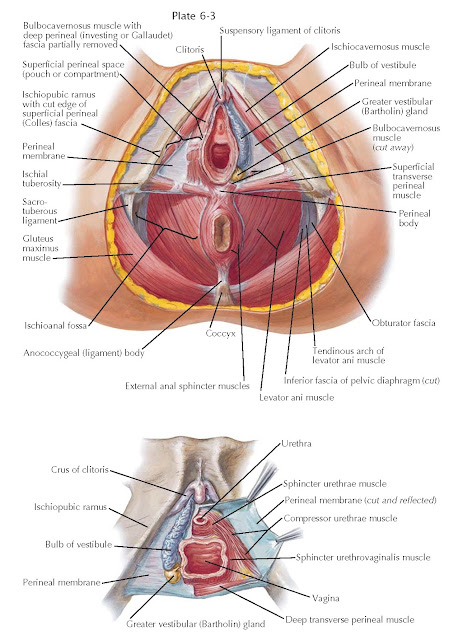PERINEUM
The mons veneris in front, the buttocks behind, and the thighs laterally bound the perineum. More deeply, it is limited by the margins of the pelvic outlet, namely, the pubic symphysis and arcuate ligament, ischiopubic rami, ischial tuberosities, sacrotuberous ligaments, sacrum, and coccyx. A transverse line joining the ischial tuberosities divides the perineum into an anterior urogenital and a posterior anal triangle.
The perineal floor is composed of skin and two layers of superficial
fasciae a superficial fatty stratum
and a deeper membranous one. The former is continuous anteriorly with the
superficial fatty layer of the abdomen (Camper fascia) and posteriorly with the
ischiorectal fat. The deeper, membranous layer of the superficial perineal
fascia (Colles fascia) is limited to the anterior half of the perineum.
Laterally, it is attached to the ischiopubic rami; posteriorly, it blends with
the base of the urogenital diaphragm; and anteriorly, it is continuous with the
deep layer of the superficial abdominal fascia (Scarpa fascia).
The urogenital diaphragm is a strong, musculomembranous partition
stretched across the anterior half of the pelvic outlet between the ischiopubic
rami. It is composed of superior and inferior fascial layers between which are
located the deep perineal muscles, the sphincter of the membranous urethra, and
the pudendal vessels and nerves. It is pierced by the urethra and vagina.
The anal triangle is delineated by the superficial perineal muscles
anteriorly, the sacrotuberous ligaments and margins of the gluteus maximus
laterally, and the coccyx posteriorly. It contains the anal canal and its
sphincters, the anococcygeal body, and the ischiorectal fossae.
The ischiorectal fossae are prismatic in shape. The lateral wall of each
is formed by the obturator internus fascia, and its medial wall by the fascia
overlying the levatorani, the coccygeus, and the external anal sphincter
muscles. The tendinous arch marks its apex. Anteriorly, the fossa extends
between the urogenital and pelvic diaphragms. Posteriorly, the sacrotuberous
ligament and gluteus maximus muscle limits it. The contents of the ischiorectal
fossa include an abundance of fat, the inferior hemorrhoidal vessels and
nerves, and the internal pudendal vessels and nerves within Alcock canal.
The muscles of the perineum include the bulbocavernosus, the
ischiocavernosus, the superficial and deep transverse perineal muscles, the
sphincter of the membranous urethra, and the external anal sphincter. These
muscles, in general, correspond to their homologues in the male. The
ischiocavernosus muscles are smaller than in the male. They overlie and insert
into the crura of the clitoris instead of into the crura of the penis, as in
the male. The bulbocavernosus muscles surround the orifice of the vagina and
cover the vestibular bulbs. They are attached posteriorly to the central
tendinous point of the perineum and to
the inferior fascia of the urogenital diaphragm and insert anteriorly into the
corpora cavernosa clitoris. They are sometimes termed the sphincter vaginae.
Spasms in this muscle group are often found in patients with vaginismus. The
pair of deep transverse perineal muscles (within the urogenital diaphragm) is
interrupted near the midline by the vagina, into which they insert.
The central point of the perineum lies at the base of the urogenital
diaphragm between the vaginal and anal orifices. It is a
common fibrous point of attachment for the bulbocavernosus, the superficial and
deep transverse perineal, the levatorani, and the external anal sphincter
muscles. This area is often referred to as the perineal body.
The anococcygeal body is of fibromuscular consistency and extends from the
anus to the coccyx. It receives fibers from the external anal sphincter and the
levatorani muscles and serves as a support for the anal canal.





